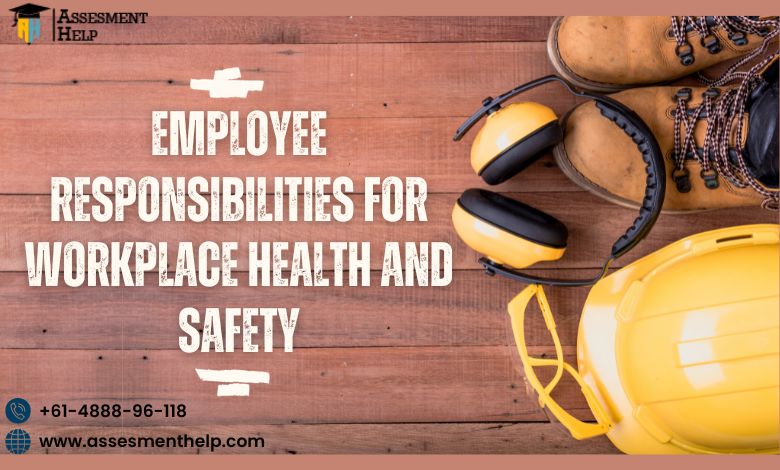Employee Responsibilities for Workplace Health and Safety

In any professional environment, the well-being of all is of utmost importance. While the onus for a secure workplace doesn’t solely fall on the shoulders of employers and management, it is equally essential for every employee to actively participate in and uphold safety standards. This article will focus on the pivotal roles that employees play in ensuring workplace health and safety, emphasizing the significance of their active involvement in creating a safe and flourishing work atmosphere. If you need help with nursing assessment, we’ve got you covered.
Introduction About HLTWHS001 Workplace Health and Safety
HLTWHS001 Workplace health and safety, often abbreviated as WHS, HSE, or OHS, is a multidimensional concept aimed at protecting the physical and mental well-being of all employees. It encompasses measures to prevent accidents, injuries, and occupational diseases while promoting a culture of health. Let’s take a closer look at the significance of this topic.
The Importance of HLTWHS001 Workplace Health and Safety
Ensuring workplace health and safety is crucial for several reasons. First and foremost, it safeguards the lives of employees, reducing the risk of accidents and injuries. Moreover, it has a direct impact on productivity, morale, and overall job satisfaction. Compliance with health and safety regulations can also prevent legal issues, fines, and damage to a company’s reputation.
Legal Framework and Regulations
Workplace health and safety are not just good practices; they are often mandated by law. Various local, national, and international regulations require employers to provide a safe and healthy working environment. Employees should be aware of these laws and regulations to help ensure compliance.
Employee Responsibilities
a. Understanding Workplace Hazards
One of the primary responsibilities of employees is to be aware of potential workplace hazards. This includes identifying risks, unsafe practices, or equipment malfunctions. Vigilance and communication with superiors are essential in this regard.
b. Reporting Safety Concerns
If an employee identifies a safety concern, they should report it immediately to their supervisor or the designated safety officer. Early reporting can prevent accidents and improve overall safety.
c. Proper Use of Safety Equipment
Employees must use safety equipment provided to them, such as helmets, goggles, gloves, or any specialized gear. Proper usage significantly reduces the risk of injury.
d. Emergency Preparedness
Being prepared for emergencies is crucial. Employees should know the location of emergency exits, first aid kits, and fire extinguishers. Participating in drills and training sessions is vital to ensure everyone knows how to react in case of emergencies.
Promoting a Culture of Safety
Employees play a key role in fostering a culture of safety. This includes setting a personal example by following safety guidelines and encouraging colleagues to do the same.
Benefits of Employee Engagement
Engaged employees are more likely to prioritize safety. By actively participating in workplace health and safety measures, they not only protect themselves but also contribute to the overall well-being of their coworkers.
Training and Education
To fulfill their responsibilities, employees should undergo regular training and education on workplace health and safety with nursing assessment. This equips them with the knowledge and skills necessary to identify risks and respond appropriately.
Management’s Role
While employees have their responsibilities, management assessment help should also lead by example and provide the necessary resources for a safe workplace. Effective leadership creates an environment where employees feel empowered to participate actively in safety efforts.
Workplace Health Initiatives
Some workplaces may introduce health initiatives such as wellness programs and ergonomic improvements. Employees should take advantage of such programs and provide feedback to make them more effective.
Case Studies of Employee Responsibilities
Real-life case studies can illustrate the importance of employees’ responsibilities in ensuring workplace health and safety. These stories can serve as learning experiences for all.
Handling Workplace Health and Safety Incidents
In the unfortunate event of an incident, employees should know how to respond and provide assistance. First aid training is invaluable in such situations.
Employee Rights
Employees also have rights related to workplace health and safety. These rights include the ability to refuse unsafe work and to be protected from retaliation for reporting safety concerns.
Conclusion
In summary, employees’ crucial roles in ensuring workplace health and safety are vital for fostering a safe and flourishing work environment. Through their awareness, reporting, and active involvement in safety protocols, employees not only safeguard themselves but also bolster the welfare of their peers and the overall prosperity of their organization. If you require help with assessment assistance, we’re here to support you.
FAQs
1. Are employees legally obligated to report safety concerns in the workplace?
Yes, in many jurisdictions, employees are legally obligated to report safety concerns to their supervisors or safety officers to ensure a safe working environment.
2. What should employees do in case of an emergency at the workplace?
In case of an emergency, employees should follow their workplace’s emergency procedures, including evacuating the area, seeking first aid, and alerting the appropriate authorities.
3. Can employees refuse to work in unsafe conditions?
Yes, employees have the right to refuse to work in unsafe conditions. They should report such conditions to their supervisors and, if necessary, relevant authorities.
4. How can employees contribute to creating a culture of safety in the workplace?
Employees can contribute to a culture of safety by following safety guidelines, reporting concerns, and encouraging their colleagues to do the same.
5. What are some common workplace hazards employees should be aware of?
Common workplace hazards include slip and fall risks, ergonomic issues, chemical exposure, electrical hazards, and fire risks. Employees should receive training on identifying and addressing these hazards.
You Can Also Read:- Cultivating Curiosity in Learning: Unlocking the Key to Academic Success



